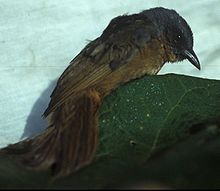Sphenopsis: Difference between revisions
add some taxonomy |
→Taxonomy and species list: Hemispingus is no more |
||
| Line 14: | Line 14: | ||
==Taxonomy and species list== |
==Taxonomy and species list== |
||
The four species now placed in this genus were formerly assigned to the genus '' |
The four species now placed in this genus were formerly assigned to the genus ''Hemispingus''. A [[molecular phylogenetic]] study published in 2014 found that ''Hemispingus'' was [[polyphyletic]] and as part of the subsequent rearrangement, the genus ''Sphenopsis'' was resurrected for these four species.<ref>{{cite journal| last1=Burns | first1=K.J. | last2=Shultz | first2=A.J. | last3=Title | first3=P.O. | last4=Mason | first4=N.A. | last5=Barker | first5=F.K. | last6=Klicka | first6=J. | last7=Lanyon | first7=S.M. | last8=Lovette | first8=I.J. | year=2014 | title=Phylogenetics and diversification of tanagers (Passeriformes: Thraupidae), the largest radiation of Neotropical songbirds | journal=Molecular Phylogenetics and Evolution| volume=75| pages=41–77 | doi=10.1016/j.ympev.2014.02.006 }}</ref><ref>{{ cite journal | last1=Burns | first1=K.J. | last2=Unitt | first2=P. | last3=Mason | first3=N.A. | year=2016 | title=A genus-level classification of the family Thraupidae (Class Aves: Order Passeriformes) | journal=Zootaxa | volume=4088 | issue=3 | pages=329–354 | doi=10.11646/zootaxa.4088.3.2 }}</ref><ref name=ioc>{{cite web| editor1-last=Gill | editor1-first=Frank | editor1-link=Frank Gill (ornithologist) | editor2-last=Donsker | editor2-first=David | editor3-last=Rasmussen | editor3-first=Pamela | editor3-link=Pamela Rasmussen | date=July 2020 | title=Tanagers and allies | work=IOC World Bird List Version 10.2 | url=https://www.worldbirdnames.org/bow/tanagers/ | publisher=International Ornithologists' Union | accessdate=9 November 2020 }}</ref> The genus had been introduced in 1862 by the English zoologist [[Philip Sclater]] with the [[type species]] as ''Sphenopsis ignobilis'', a taxon that is now treated as a [[subspecies]] of the [[oleaginous hemispingus]].<ref name=ioc/><ref>{{ cite journal | last=Sclater | first=Philip Lutley| author-link=Philip Sclater | year=1861 | title=Descriptions of twelve new species of American birds, of the families Dendrocolaptidae, Formicariidae, and Tyrannidae | journal=Proceedings of the Zoological Society of London | pages=377-383 [379] | url=https://www.biodiversitylibrary.org/page/28672925 }} Although the title page is dated 1861, the article was not published until 1862.</ref> The name ''Sphenopsis'' combines the [[Ancient Greek]] ''sphēn'' meaning "wedge" with ''opsis'' meaning "appearance".<ref>{{cite book | last=Jobling | first=James A. | year=2010| title=The Helm Dictionary of Scientific Bird Names | publisher=Christopher Helm | location=London | isbn=978-1-4081-2501-4 | page=361 }}</ref> |
||
The four species in the genus are:<ref name=ioc/> |
The four species in the genus are:<ref name=ioc/> |
||
Revision as of 21:58, 9 November 2020
| Sphenopsis | |
|---|---|

| |
| Black-eared hemispingus (Sphenopsis melanotis) | |
| Scientific classification | |
| Domain: | Eukaryota |
| Kingdom: | Animalia |
| Phylum: | Chordata |
| Class: | Aves |
| Order: | Passeriformes |
| Family: | Thraupidae |
| Genus: | Sphenopsis Sclater, 1862 |
| Type species | |
| Sphenopsis ignobilis Sclater, PL, 1862
| |
| Species | |
|
See text | |
Sphenopsis is a genus of warbler-like birds in the tanager family Thraupidae. They are found in highland forest of South America.
Taxonomy and species list
The four species now placed in this genus were formerly assigned to the genus Hemispingus. A molecular phylogenetic study published in 2014 found that Hemispingus was polyphyletic and as part of the subsequent rearrangement, the genus Sphenopsis was resurrected for these four species.[1][2][3] The genus had been introduced in 1862 by the English zoologist Philip Sclater with the type species as Sphenopsis ignobilis, a taxon that is now treated as a subspecies of the oleaginous hemispingus.[3][4] The name Sphenopsis combines the Ancient Greek sphēn meaning "wedge" with opsis meaning "appearance".[5]
The four species in the genus are:[3]
- Oleaginous hemispingus, Sphenopsis frontalis
- Black-eared hemispingus, Sphenopsis melanotis
- Piura hemispingus, Sphenopsis piurae
- Western hemispingus, Sphenopsis ochracea
References
- ^ Burns, K.J.; Shultz, A.J.; Title, P.O.; Mason, N.A.; Barker, F.K.; Klicka, J.; Lanyon, S.M.; Lovette, I.J. (2014). "Phylogenetics and diversification of tanagers (Passeriformes: Thraupidae), the largest radiation of Neotropical songbirds". Molecular Phylogenetics and Evolution. 75: 41–77. doi:10.1016/j.ympev.2014.02.006.
- ^ Burns, K.J.; Unitt, P.; Mason, N.A. (2016). "A genus-level classification of the family Thraupidae (Class Aves: Order Passeriformes)". Zootaxa. 4088 (3): 329–354. doi:10.11646/zootaxa.4088.3.2.
- ^ a b c Gill, Frank; Donsker, David; Rasmussen, Pamela, eds. (July 2020). "Tanagers and allies". IOC World Bird List Version 10.2. International Ornithologists' Union. Retrieved 9 November 2020.
- ^ Sclater, Philip Lutley (1861). "Descriptions of twelve new species of American birds, of the families Dendrocolaptidae, Formicariidae, and Tyrannidae". Proceedings of the Zoological Society of London: 377-383 [379]. Although the title page is dated 1861, the article was not published until 1862.
- ^ Jobling, James A. (2010). The Helm Dictionary of Scientific Bird Names. London: Christopher Helm. p. 361. ISBN 978-1-4081-2501-4.
